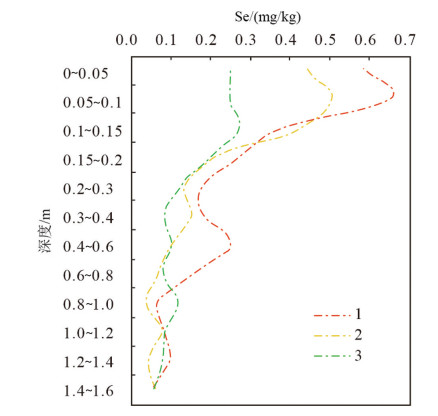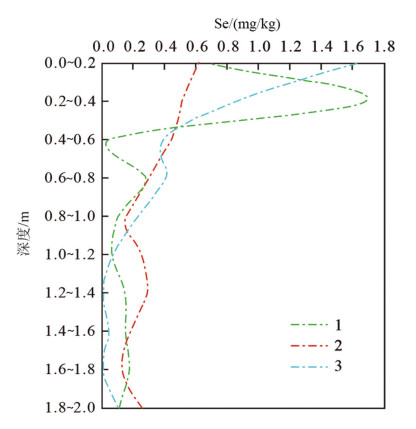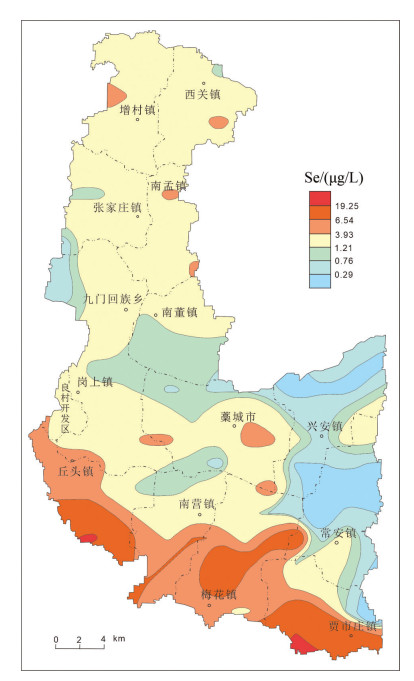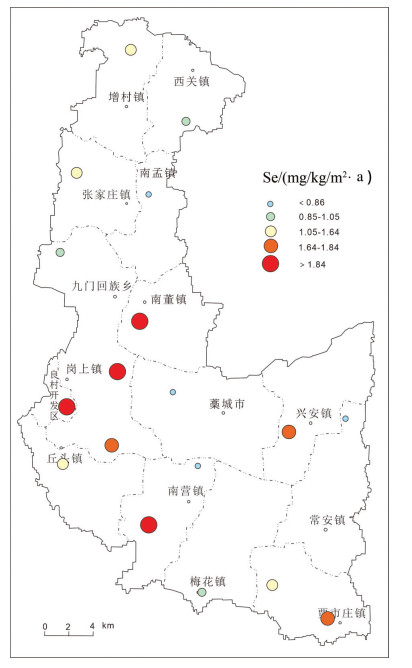Characteristics, causes and ecological environment health evaluation of Selenium-enriched soil in Gaocheng District of Shijiazhuang City, Hebei Province
-
摘要:
硒对人体健康有着重要影响。本文以藁城为研究区,利用HG-AFS及ICP-MS等对研究区不同介质中的硒和重金属元素含量进行测试分析,探讨了藁城土壤硒含量特征、主要成因及来源,并对该地生态环境健康进行了评价。结果表明,藁城表层土壤硒均值为0.32 mg/kg,富集系数达到1.68,在研究区南部普遍较高,约171.12 km2达到富硒土壤标准;富硒土壤成因以人为成因为主,主要来源为燃煤和灌溉水;富硒区农产品硒含量远高于非富硒区,部分达到天然富硒食品标准,居民硒摄入量约为123.47 mg/d,处于合理水平;重金属污染程度由高到低依次为Cd>Hg>Pb>Cu>Zn>Ni>As,单项重金属潜在生态风险评价显示Cd和Hg为主要危害元素,其余重金属潜在风险较低;重金属人体健康风险评价表明:研究区非致癌和致癌风险指数均处于安全范围内,口摄入是产生健康风险的主要途径,儿童相较于成人更易受到危害。
Abstract:Selenium has an important impact on human health. This paper takes Gaocheng as a research object to test and analyze the content of selenium and heavy metal elements in different media in the study area with HG-AFS and ICP-MS method. Based on the discussing of the characteristics, main causes and sources of selenium content in soil, the health of the local ecological environment is evaluated. The results show that the average selenium in the surface soil of Gaocheng is 0.32mg/kg, and the enrichment coefficient reaches 1.68, which is generally higher in the southern part of the study area, about 171.12 km2 reaching the standard of selenium-rich soil. The selenium enrichment in soil is mainly caused by human beings, and its main sources are coal burning and irrigation water. The selenium content of agricultural products in the selenium-rich area is much higher than that in the non-selenium-rich area, part of which meets the natural selenium-rich food standard. The selenium intake of residents is about 123.47 mg/d, which is at a reasonable level. The heavy metal pollution degree is Cd> Hg> Pb> Cu> Zn> Ni> As. The ecological risk assessmen of a single heavy metal t shows that Cd and Hg are the main hazard elements, and the other heavy metal potential risks are low. The human health risk assessment of heavy metals indicates that the non-carcinogenic and carcinogenic risk indexes in the study area are within a safe range, and oral intake is a source of health. Children are more vulnerable to oral intake than adults.
-
Key words:
- selenium-enriched soil /
- causes /
- sources /
- ecological and environmental health /
- Gaocheng /
- Hebei Province
-

-
表 1 输入输出通量计算参数
Table 1. Input and output flux calculation parameters
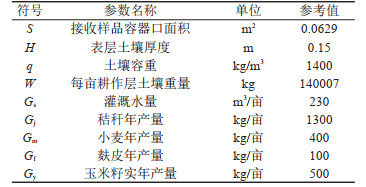
表 2 地累积指数污染程度划分标准
Table 2. Standards for dividing the pollution degree of the land accumulation index
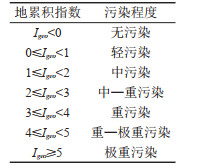
表 3 Hakanson潜在生态危害评价指标
Table 3. Hakanson potential ecological hazard evaluation index

表 4 重金属健康风险暴露参数
Table 4. Exposure parameters of heavy metal health risk
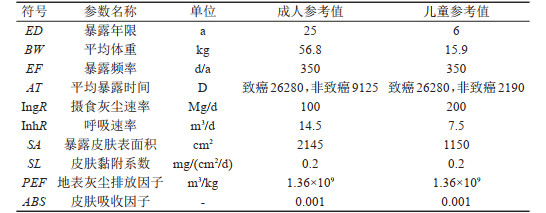
表 5 重金属不同暴露途径参考计量和致癌斜率因子
Table 5. Reference measurement and carcinogenic slope factor for different exposure routes of heavy metals

表 6 表层土壤硒与重金属元素含量统计
Table 6. Statistics of selenium and heavy metal elements in surface soil

表 7 富硒区和非富硒区小麦、玉米及鸭梨硒含量对比
Table 7. Selenium content comparison of wheat, corn and pear in selenium-rich with non-selenium-rich areas
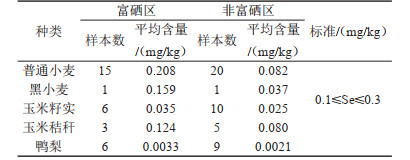
表 8 富硒区和非富硒区猪肉、肝、肾及鸡蛋硒含量对比
Table 8. Selenium content comparison of pork, liver, kidney and eggs in selenium-rich area with non-selenium-rich area

表 9 土壤重金属污染地累积指数分级统计
Table 9. Classification statistics of cumulative index of heavy metal contaminated soil

表 10 土壤重金属的潜在生态危害指数统计
Table 10. Statistics of potential ecological hazard index of heavy metals in soil

表 11 土壤重金属非致癌平均日暴露量(mg/kg·d)
Table 11. Average daily non-carcinogenic exposure to heavy metals in soil (mg/kg·d)

表 12 土壤重金属致癌平均日暴露量(mg/kg·d)
Table 12. Average daily carcinogenic exposure to heavy metals in soil (mg/kg·d)

表 13 土壤重金属非致癌健康风险指数
Table 13. Non-carcinogenic health risk index of heavy metals in soil

表 14 土壤重金属致癌健康风险指数
Table 14. Carcinogenic health risk index of soil heavy metal

-
An Yonglong, Huang Yong, Zhang Yanling, Qu Xueyan. 2020. Bioavailability and source analyses of Se-enriched soil in the south of Fangshan district, Beijing[J]. Geological Bulletin of China, 39(Z1): 387-399(in Chinese with English abstract).
Bao Liran, Deng Hai, Jia Zhongmin, Li Yu, Dong Jinxiu, Yan Mingshu, Zhang Fenglei. 2020. Ecological and health risk assessment of heavy metals in farmland soil in northwest Xiushan, Chongqing[J]. Geology in China, 47(6): 1625-1636(in Chinese with English abstract).
Chen Jinping, Liu Yongxian, Zeng Chengcheng, Pan Liping, Xing Ying, Liao Qing, Liang Panxia, Jiang Zepu. 2019. Research advances in the effects of rainfall on soil selenium migration and transformation[J]. Chinese Journal of Ecology, 38(6): 1909-1915(in Chinese with English abstract). http://en.cnki.com.cn/Article_en/CJFDTotal-STXZ201906035.htm
Chen Jiping, Ren Rui, Wang Hui, Luo Ting, Chao Xu, Zhang Zhimin, Hu Kui. 2020. Effect of lou soil pH change on selenium forms and availability[J]. Northwestern Geology, 53(1): 254-260 (in Chinese with English abstract).
Chen Liang, Li Tao. 2004. Element selenium and human body health[J]. Studies of Trace Elements and Health, 21(3): 58-597(in Chinese with English abstract). http://en.cnki.com.cn/Article_en/CJFDTOTAL-WYJK200403027.htm
Chen Wenjing. 2008. Shallow Groundwater Geochemical Evaluation of Hebei Plain[D]. Inner Mongolia Agricultural University, 16-17(in Chinese with English abstract).
China Environmental Monitoring Station. 1990. Chinese Soil Element Background Values[M]. Beijing: China Science Press, 87-496(in Chinese).
Cui Liye. 2010. Analysis on Unitary Development of Urban and Rural Within the Urban Area[D]. Hebei Normal University, 14-15(in Chinese with English abstract).
Ferreira-Baptista L, De Miguel E. 2005. Geochemistry and risk assessment of street dust in Luanda, Angola: A tropical urban environment[J]. Atmospheric Environment, 39 (25): 4501-4512. doi: 10.1016/j.atmosenv.2005.03.026
Gao J, Liu Y, Huang Y, Lin Z Q, Banuelos G S, Lam H W, Yin X B. 2011. Daily selenium intake in a moderate selenium deficiency area of Suzhou, China[J]. Food Chemistry, 126(3): 1088-1093. doi: 10.1016/j.foodchem.2010.11.137
Hakanson L. 1980. An ecological risk index for aquatic pollution control a sediment to logical approach[J]. Water Research, 14(8): 975-1001. doi: 10.1016/0043-1354(80)90143-8
He Yufu, Zhang Jian, Liu Jia, Liu Fengxia, Wang Yuejin. 2008. Investigation of dietary nutrition intake of residents in some areas of Hebei Province[C]//Chinese Nutrition Society. Proceedings of public nutrition branch of the 10th National Nutrition Academic Conference of Chinese Nutrition Society. Chinese Nutrition Society: Public Nutrition Branch of Chinese Nutrition Society, 54-59 (in Chinese).
Huang Yimin, Yu Xin, Han Ling, Gu Yun, Jin Ming, Chen Baotian, Guo Jinliang, Li Yong. 1998. Protective effect of selenium on human erythrocyte rheology[J]. Beijing Biomedical Engineering, 17(2): 100-107(in Chinese with English abstract). http://www.en.cnki.com.cn/Article_en/CJFDTOTAL-BJSC802.008.htm
Jiang Xia, Zhang Li, Cui Yujun, Li Ying. 2020. Spatial distribution of soil selenium and its relation with soil properties in Suiling County, Heilongjiang Province[J]. Geology and Resources, 29(6): 592-596, 578 (in Chinese with English abstract).
Li Jiaxi, Zhang Guangdi, Ge Xiaoli. 2000. Geochemical Environmental Characteristics and Prediction of Human Selenium Deficiency and Surplus[M]. Beijing: Geological Publishing House, 5-8((in Chinese).
Li Ning, Zhao Huijuan. 2011. Investigation of copper, manganese, zinc and selenium contents in vegetables, fruits, grains and fresh meat in Jinan, Shandong[J]. Journal of Environment and Health, 28(7): 613-615 (in Chinese with English abstract). http://en.cnki.com.cn/Article_en/CJFDTOTAL-HJYJ201107018.htm
Li Zhenning. 2010. The Study of Source Tracking of Se Anomaly and Ecological Appraisal in Plain Terrain of Hebei[D]. Shijiazhuang University of Economics, 21-22 (in Chinese with English abstract).
Liao Qilin, Cui Xiaodan, Huang Shunsheng, Huang Biao, Ren Jinghua, Gu Xueyuan, Fan Jian, Xu Hongting. 2020. Elemental geochemistry of Selenium-enriched soil and its main origin in Jiangsu Province[J]. Geology in China, 47(6): 1813-1825(in Chinese with English abstract).
Liao Qilin, Ren Jinghua, Xu Weiwei, Cui Xiaodan, Jin Yang, Li Wenbo, Fan Jian, Zhu Bowan. 2016. Geological and geochemical background of Se-rich rice production in Yili area, Jiangsu Province[J]. Geology in China, 43(5): 1791-1802(in Chinese with English abstract). http://en.cnki.com.cn/Article_en/CJFDTOTAL-DIZI201605027.htm
Luan Wenlou, Li Suimin, Cui Xingtao, Song Zefeng. 2012. Regional Eco-Geochemical Evaluation of Hebei Plain[D]. Beijing: Geological Publishing House, 299-230(in Chinese).
Ministry of Environmental Protection of the People's Republic of China. 2014. HJ 25.3-2014, Technical Guidelines for Risk Assessment of Contaminated Sites[S]. Beijing: China Environmental Science Press, 53-55(in Chinese).
Muller G. 1969. Index of geoaccumulation in sediments of the Rhime River[J]. Geological Journals, (2): 109-118. http://ci.nii.ac.jp/naid/10030367619
Peng Xi, Cui Hengmin. 2010. Advance in effects of selenium on immune function[J]. Chinese Veterinary Science, 40(8): 867-872(in Chinese with English abstract). http://www.cabdirect.org/abstracts/20103344406.html
Qi Yuwei, Shi Changyi. 2005. Se ecological environment and human body health[J]. Studies of Trace Elements and Health, (2): 63-66(in Chinese with English abstract).
Qin Haibo, Zhu Jianming, Zhu Yongxuan, Lei Lei. 2009. Advances in research on atmospheric selenium[J]. Earth and Environment, 37(3): 304-314(in Chinese with English abstract). http://en.cnki.com.cn/Article_en/CJFDTOTAL-DZDQ200903018.htm
Qiu Huiyuan. 2017. Prediction of Soil Heavy Metal Pollution in the Eastern Part of Baoding[D]. Hebei GEO University, 23-24(in Chinese with English abstract).
Rotruck J T, Pope A L, Ganther H E, Swanson A B. Hafeman D G, Hoekstra W G. 1973. Selenium: Biochemical role as a component of glutathione peroxidase[J]. Science, 79(4073): 588-590. http://newmed.wanfangdata.com.cn/Paper/Detail/PeriodicalPaper_PM4686466
Shijiazhuang Gaocheng District Local Chronicle Compilation Committee. 2019. Shijiazhuang Gaocheng Yearbook (2018)[M]. Hebei: Hebei People's Publishing House, 51-55(in Chinese).
Su Xiaoyun. 1998. Development and Utilization of Selenium Resources in China[M]. Beijing: China Meteorological Press, 17-139(in Chinese).
Tahtat D, Benamar M A, Aklil K, Mouzai M, Azebouche A. 2003. Selenium intake in food ration in the region of Algiers[J]. Trace Microprobe Tech., 21: 181-188. doi: 10.1081/TMA-120017914
Tan J A, Zhu W, Wang W, Li R B, Hou S F, Wang D C, Yang L S. 2002. Selenium in soil and endemic diseases in China[J]. Science of the Total Environment, 284(1/3): 227-235. http://europepmc.org/abstract/med/11846167
Tan Jianan. 1989. Atlas of Endemic Diseases and Environment of the People's Republic of China[M]. Beijing: Science Press, 1-118((in Chinese).
USEPA. 2011. Exposure Factors Handbook[R]. Washington: National Center for Environmental Assessment.
USEPA. 1989. Risk Assessment Guidance for Superfund, vol. I: Human Health Evaluation Manual[R]. Washington, DC: Office of Emergency and Remedial Response, 15-28.
Wang Changyu, Zhang Surong, Liu Jihong, Xing Yi, Yang Junquan. 2019. Evaluation of the characteristic land resources with Zn、Se and their ecological effects in Raoyang county of Hebei province[J]. Geological Survey and Research, 42(1): 49-56 (in Chinese with English abstract). http://www.zhangqiaokeyan.com/academic-journal-cn_geological-survey-research_thesis/0201270248696.html
Wang Wuyi, Wang Dacheng, Wang Weizhong, Wang Lizhen. 1992. A preliminary study on leaching of selenium in the soils of china. Geographical Research, 11(2): 34-40(in Chinese with English abstract).
Wang Zhe, Liu Shaoqing, Chen Xiaomin, Lin Chunye. 2008. Estimates of the exposed dermal surface area of Chinese in view of human health risk assessment[J]. Journal of Safety and Environment, 8(4): 152-155(in Chinese with English abstract). http://www.cnki.com.cn/Article/CJFDTotal-AQHJ200804038.htm
Wei Huijuan, Luo Xianchou, Xing Jie, Feng Yimin, Mao Baolin, Wang Yinglong, Chen Zhongliu. 1987. Selenium intake and metabolic study in workers of Yunnan Tin Mine[J]. Acta Academiae Medicinaf Snincae, 9(3): 198-201(in Chinese with English abstract). http://www.ncbi.nlm.nih.gov/pubmed/2958158
Xiong Yongmin, Yang Xiaoli, Zhang Dandan, Li Qiang, Zhang Di, Li Zhaofang. 2018. Research progress in biological function of selenium and environmentally associated diseases[J]. Soils, 50(6): 1105-1112(in Chinese with English abstract).
Yang Guangqi, Yin Shian, Gu Lvzhen, Zhou Ruihua, Man Ronge, Yan Benwu, Wu Tian, Chen Wenliang, Liu Xizhou, Liu Yiqing, Zhang Yougeng, Han Zhongshun, Liu Yiqi, Pu Changhe, Yu Xingtai. 1990. Studies on the maximum safe selenuim intake of humans Ⅰ. selenium intake and tissue-selenium level of inhabitants[J]. Journal of Hygiene Research, (2): 24-28, 56(in Chinese with English abstract). http://en.cnki.com.cn/Article_en/CJFDTOTAL-WSYJ199102009.htm
Yang Guangqi, Zhou Ruihua, Sun Shuzhuang, Wang Shuzhen, Li Shensi. 1982. Endemic selenium intoxication of man in China and the selenium levels of human body and environment[J]. Acta Nutrimenta Sinca, (2): 81-89(in Chinese with English abstract) http://en.cnki.com.cn/Article_en/CJFDTOTAL-YYXX198202000.htm
Yang Guangqi. 1989. Studies on human requirement of selenium[J]. Chinese Journal of Endemiology, (5): 28-32, 59(in Chinese with English abstract). http://en.cnki.com.cn/Article_en/CJFDTOTAL-ZDFB198905007.htm
Yang Guangqi. 1992. Summary of research results on dietary selenium requirement and safe intake range[J]. Acta Nutrimenta Sinca, (3): 318-321(in Chinese).
Yang Liguo, Ma Zhichao, Wang Xin. 2019. Geochemical characteristics of selenium in the soil of Horqin District, Inner Mongolia[J]. Geology and Resources, 28(4): 383-388 (in Chinese with English abstract).
Zhang Xiuzhi, Ma Zhnogshe, Wang Zhijun, Xie Weimin. 2012. Study of geochemistry character and transportation pattern of selenium and mercury in Kailuan coal field of Tangshan[J]. Chinese Journal of Geology, 47(3): 908-920(in Chinese with English abstract). http://www.researchgate.net/publication/288135959_Study_of_geochemistry_character_and_transportation_pattern_of_selenium_and_mercury_in_Kailuan_coal_feild_of_Tangshan
Zhang Xiuzhi, Ma zhongshe. 2009. Report on Multi-objective Regional Geochemical Survey in Hebei Plain[R]. Hebei Institute of Geological Survey, 31-57 (in Chinese).
Zhang Yongsheng, Li Renlan, Liu Yan, He Yu, Huang Keke. 2018. Research progress on effects of selenium on human health[J]. Internal Medicine, 13(4): 623-625, 662(in Chinese with English abstract).
Zhang Zhehuan, Zhao Jun, Dai Huimin, He Pengfei, Wei Minghui. 2020. Geochemistry of selenium in soil-crop system of Nehe City, Heilongjiang Province[J]. Geology and Resources, 29(1): 38-43 (in Chinese with English abstract). http://www.researchgate.net/publication/348754813_Distribution_Characteristics_of_Selenium_in_a_Soil-Crop_System_and_the_Threshold_of_Selenium-Rich_Soils
安永龙, 黄勇, 张艳玲, 曲雪妍. 2020. 北京房山南部地区富硒土壤生物有效性特征及来源[J]. 地质通报, 39(Z1): 387-399. https://www.cnki.com.cn/Article/CJFDTOTAL-ZQYD2020Z1019.htm
鲍丽然, 邓海, 贾中民, 李瑜, 董金秀, 严明书, 张风雷. 2020. 重庆秀山西北部农田土壤重金属生态健康风险评价[J]. 中国地质, 47(6): 1625-1636.
陈锦平, 刘永贤, 曾成城, 潘丽萍, 邢颖, 廖青, 梁潘霞, 江泽普. 2019. 降雨对土壤硒迁移转化的影响研究进展[J]. 生态学杂志, 38(6): 1909-1915. https://www.cnki.com.cn/Article/CJFDTOTAL-STXZ201906035.htm
陈继平, 任蕊, 王晖, 罗婷, 晁旭, 张志敏, 胡奎. 2020. 关中塿土地区土壤pH变化对硒形态及有效性的影响[J]. 西北地质, 53(1): 254-260. https://www.cnki.com.cn/Article/CJFDTOTAL-XBDI202001025.htm
陈亮, 李桃. 2004. 元素硒与人体健康[J]. 微量元素与健康研究, (3): 58-59. doi: 10.3969/j.issn.1005-5320.2004.03.027
陈文婧. 2008. 河北平原浅层地下水水地球化学评价[D]. 内蒙古农业大学, 16-17.
崔立烨. 2010. 都市区内县(市)域城乡统筹发展规划探讨[D]. 河北师范大学, 14-15.
何玉伏, 张健, 刘佳, 刘风霞, 王跃进. 2008. 河北省部分地区居民膳食营养摄入状况调查[C]. 中国营养学会. 中国营养学会第十次全国营养学术会议公共营养分会论文集. 中国营养学会: 中国营养学会公共营养分会, 54-59.
黄益民, 虞欣, 韩玲, 顾云, 金鸣, 陈宝田, 郭金良, 李勇. 1998. 微量元素硒对人红细胞流变性的保护作用[J]. 北京生物医学工程, (2): 37-44. https://www.cnki.com.cn/Article/CJFDTOTAL-BJSC802.008.htm
姜侠, 张立, 崔玉军, 李瑛. 2020. 黑龙江省绥棱县土壤硒空间分布特征及其与土壤性质的关系[J]. 地质与资源, 29(6): 592-596, 578.
李家熙, 张光第, 葛晓立. 2000. 人体硒缺乏与过剩的地球化学环境特征及其预测[M]. 北京: 地质出版社, 5-8.
李宁, 赵慧娟. 2011. 济南市区蔬菜、水果、粮食和鲜肉中铜、锰、锌、硒含量调查[J]. 环境与健康杂志, 28(07): 613-615. https://www.cnki.com.cn/Article/CJFDTOTAL-HJYJ201107018.htm
李振宁. 2010. 河北省平原区土壤中硒异常源追踪及生态效应评价[D]. 石家庄经济学院, 21-22.
廖启林, 崔晓丹, 黄顺生, 黄标, 任静华, 顾雪元, 范健, 徐宏婷. 2020. 江苏富硒土壤元素地球化学特征及主要来源[J]. 中国地质, 47(6): 1813-1825.
廖启林, 任静华, 许伟伟, 崔晓丹, 金洋, 李文博, 范健, 朱伯万. 2016. 江苏宜溧富硒稻米产区地质地球化学背景[J]. 中国地质, 43(5): 1791-1802. https://www.cnki.com.cn/Article/CJFDTOTAL-DIZI201605027.htm
栾文楼, 李随民, 崔邢涛, 宋泽峰. 2012. 河北平原区域生态地球化学评价[D]. 北京: 地质出版社, 299-230.
彭西, 崔恒敏. 2010. 硒对免疫功能影响的研究进展[J]. 中国兽医科学, 40(8): 867-872. https://www.cnki.com.cn/Article/CJFDTOTAL-ZGSY201008021.htm
齐玉薇, 史长义. 2005. 硒的生态环境与人体健康[J]. 微量元素与健康研究, (2): 63-66. doi: 10.3969/j.issn.1005-5320.2005.02.029
秦海波, 朱建明, 朱咏喧, 雷磊. 2009. 大气环境中硒的存在形式、来源及通量[J]. 地球与环境, 37(3): 304-314. https://www.cnki.com.cn/Article/CJFDTOTAL-DZDQ200903018.htm
邱慧远. 2017. 保定市东部某区域土壤重金属污染预警预测[D]. 河北地质大学, 23-24.
石家庄市藁城区地方志编纂委员会. 2019. 石家庄市藁城年鉴(2018)[M]. 河北: 河北人民出版社, 51-55.
苏晓云. 1998. 中国硒资源的开发与利用[M]. 北京: 中国气象出版社, 17-139.
谭见安. 1989. 中华人民共和国地方病与环境图集[M]. 北京: 科学出版社, 1-118.
王昌宇, 张素荣, 刘继红, 邢怡, 杨俊泉. 2019. 河北省饶阳县富锌、硒特色土地及其生态效应评价[J]. 地质调查与研究, 42(1): 49-56. https://www.cnki.com.cn/Article/CJFDTOTAL-QHWJ201901007.htm
王五一, 王大成, 王卫中, 王丽珍. 1992. 我国土壤中硒的淋溶[J]. 地理研究, (2): 34-40. https://www.cnki.com.cn/Article/CJFDTOTAL-DLYJ199202004.htm
王喆, 刘少卿, 陈晓民, 林春野. 2008. 健康风险评价中中国人皮肤暴露面积的估算[J]. 安全与环境学报, (4): 152-156. doi: 10.3969/j.issn.1009-6094.2008.04.038
魏慧娟, 罗贤懋, 邢洁, 冯益民, 毛宝霖, 王应龙, 陈钟毓. 1987. 云锡工人硒摄入量与代谢研究[J]. 中国医学科学院学报, (3): 198-201. doi: 10.3321/j.issn:1000-503X.1987.03.012
熊咏民, 杨晓莉, 张丹丹, 李强, 张迪, 李昭芳. 2018. 硒的生物学效应与环境相关性疾病的研究进展[J]. 土壤, 50(6): 1105-1112. https://www.cnki.com.cn/Article/CJFDTOTAL-TURA201806008.htm
杨光圻, 荫士安, 顾履珍, 周瑞华, 满荣娥, 严本武, 吴天, 陈文亮, 刘西洲, 刘贻庆, 张友耿, 韩忠顺, 刘义奇, 普长河, 喻兴田. 1990. 硒的人体最大安全摄入量的研究——一、居民硒的日摄入量和组织硒的含量[J]. 卫生研究, (2): 24-28+56. https://www.cnki.com.cn/Article/CJFDTOTAL-WSYJ199002009.htm
杨光圻, 周瑞华, 孙淑庄, 王淑真, 李慎思. 1982. 人的地方性硒中毒和环境及人体硒水平[J]. 营养学报, (2): 81-89. https://www.cnki.com.cn/Article/CJFDTOTAL-YYXX198202000.htm
杨光圻. 1989. 人的硒需要量研究[J]. 中国地方病学杂志, (5): 28-32, 59. https://www.cnki.com.cn/Article/CJFDTOTAL-ZDFB198905007.htm
杨光圻. 1992. 膳食硒需要量和安全摄入量范围研究结果述要[J]. 营养学报, (3): 318-321. doi: 10.3321/j.issn:0512-7955.1992.03.002
杨立国, 马志超, 王鑫. 2019. 内蒙古通辽市科尔沁区土壤硒地球化学特征[J]. 地质与资源, 28(4): 383-388. doi: 10.3969/j.issn.1671-1947.2019.04.012
张秀芝, 马忠社, 郭海全. 2009. 河北平原多目标区域地球化学调查报告[R]. 河北省地质调查院, 31-57.
张秀芝, 马忠社, 王志军, 谢伟民. 2012. 唐山开滦煤矿区Se、Hg元素地球化学特征及其迁移循环规律研究[J]. 地质科学, 47(3): 908-920. doi: 10.3969/j.issn.0563-5020.2012.03.024
张勇胜, 李仁兰, 刘妍, 贺瑜, 黄可可. 2018. 硒对人体健康作用的研究进展[J]. 内科, 13(4): 623-625, 662. https://www.cnki.com.cn/Article/CJFDTOTAL-NKYT201804026.htm
张哲寰, 赵君, 戴慧敏, 贺鹏飞, 魏明辉. 2020. 黑龙江省讷河市土壤-作物系统Se元素地球化学特征[J]. 地质与资源, 29(1): 38-43. doi: 10.3969/j.issn.1671-1947.2020.01.005
中国环境监测总站. 1990. 中国土壤元素背景值[M]. 北京: 中国科学出版社, 87-496.
中华人民共和国环境保护部. 2014. HJ 25.3-2014, 污染场地风险评估技术导则[S]. 北京: 中国环境科学出版社, 53-55.
-



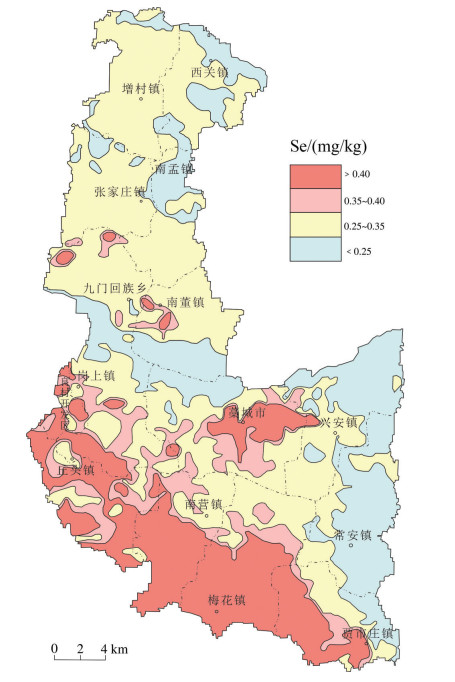
 下载:
下载:
